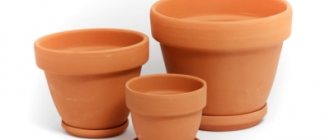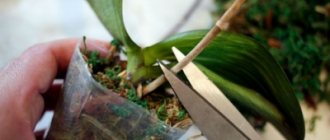Is it possible to replant a plant during flowering?
After purchasing it from the store
Often orchids stand in the store for a very long time, and the pot becomes too small for them . If the purchased plant has roots sticking out of the container, it needs to be replanted. You need to act as carefully as possible - the orchid is a very fragile and delicate plant.
Read more about whether an orchid transplant is necessary after purchase and how to carry out the procedure here.
Which has been at home for a long time
There are certain circumstances in which replanting is urgently necessary - this happens if the plant is sick and there is a choice, or beautiful flowers, or the death of a specimen after flowering.
Further flower care
After transplantation, no special care is required. The only thing is to shade the upper part of the flower from the sunny color during the week.
Watering is done immediately. Water needs to be boiled with the addition of calcium and magnesium. The entire pot is immersed in it for 40 minutes. Thus, the soil is saturated with nutrients. The next moisturizing procedure should be carried out no earlier than 2 weeks later. Fertilizing is applied after 3 weeks.
There is a place for an orchid in any house or apartment. It will delight not only the owners, but also the guests with its beauty and amazing aroma. With proper care it blooms long and beautifully. In the direction of Feng Shui, the orchid is also used. Not cut, but indoor representative is perfect. Its belonging to noble plants has a beneficial effect on the atmosphere in the house. Capable of activating zones in a positive direction. In an ancient Japanese legend, there is a belief that an orchid, having a feminine name, is considered a male flower. Combining 2 elements, it is suitable for balance in the family.
By following the general rules for caring for a flowering orchid when transplanting, you can protect it from diseases and pests. The main thing is to monitor the condition of the root system. A timely moistened substrate is a guideline for subsequent actions. Most varieties of orchids sold in stores are hybrids. They are adapted to environmental conditions, weather and pests. Therefore, there should be no problems in transplanting or growing.
Is it worth doing this?
This question cannot be answered unequivocally, since everything depends on the specific situation. For any plant, replanting is stressful, especially during flowering . So before replanting a flowering plant, you need to weigh the pros and cons.
And yet, is it possible to replant an orchid after purchase if it has released a peduncle, how can it be replanted into another pot during its growth and preserve the flower?
It is worth understanding that during flowering the plant is greatly weakened and by replanting it at this time you aggravate the situation to a critical level . Let's consider the consequences that will negatively affect the orchid:
- if the transplant is done carelessly, the orchid will not only drop its flowers, but may also die;
- the duration of flowering may be significantly reduced;
- the plant may not soon produce a second peduncle;
- the flower may stop growing and developing.
But replanting an orchid during flowering also has certain advantages:
- if the plant is affected by pests, then this is an excellent opportunity to save it from death;
- if the pot has become small, then replanting will help place the orchid in a more nutritious substrate, from which the leaf part will begin to grow and develop faster;
- the ability to protect other plants in the room from pests and infections.
Important : When a flowering orchid is transplanted, the peduncle needs to be shortened slightly. Of course, there will be fewer flowers, but the remaining ones will be large and bright, and the orchid will release the next arrow faster.
Read more about the time for transplantation here, and in more detail about whether it is possible to transplant a beauty when it has released an arrow, read this material.
Why replant an orchid?
It is recommended to replant a flowering plant only in the following cases:
- the foliage significantly exceeds the volume of the flowerpot;
- after acquisition, damage by diseases and insect pests was discovered;
- pronounced growth of roots or their rotting;
- leaves wither and turn yellow;
- poor quality substrate.
Attention! In these cases, an urgent transplant is recommended, even despite abundant flowering, otherwise the orchid will die.
When is the best time to move the plant?
If an orchid bought in a store is crowded in a pot, with numerous roots sticking out of it, then you can immediately move the flower to a larger pot. If you transplant the orchid carefully, without destroying the old earthen lump, then it will easily endure this procedure .
If you need to carry out the replanting process according to vital signs, then it is better to cut off the peduncle at the first dormant bud. The plant will spend energy on restoration and growth, and next time it will bloom more magnificently and beautifully.
We recommend watching a video about replanting an orchid after purchasing:
Tips and tricks
Some tips will help you replant your orchid so that it continues to delight you with its flowering. So, after washing the roots from the old soil, they need to be dried for a long time, about 7 hours. Drainage can be not only expanded clay, but, for example, broken brick, but only crushed, and even pebbles.
If the orchid has already grown greatly, then it should be divided into two pots. After transplantation, such a plant should be cared for more carefully and thoroughly. It is always worth remembering that any transplant for an orchid is a lot of stress, so you should be careful and competent about this procedure.
If gardeners were wondering whether it is possible to replant an orchid when it is blooming, now they no longer face such a question.
When is it necessary to urgently change the soil and pot?
There are several indicators according to which a plant is replanted urgently:
- the flower has been infected by a mite or is sick;
- the roots have grown very strongly;
- due to waterlogging of the soil, rotting of the root system began;
- upon purchase, a low-quality substrate was discovered in the pot, which caked and did not allow the plant to feed properly;
- the leaves began to turn yellow;
- the leaf mass is several times larger in volume than the pot;
- the roots have grown to the ceramic planter.
If the roots of the plant begin to rot, the peduncle must be removed so that it has the strength to take root. This transplant is very complicated, so you need to strictly follow the instructions.
If there are no indications for replanting listed above, then it is better not to touch the orchid until flowering stops . This way the flower will avoid unnecessary stress and will not get sick.
We recommend watching a video about the reasons for urgent transplantation of a blooming orchid:
You can also find out whether it is possible to replant an orchid in the fall and how to properly replant a baby orchid at home.
When can you do this at home?
There is no period for a blooming orchid when it is best to replant it . All the time - from the release of the arrow to the last flower - this is not shown unless there are some “BUTs”.
When the peduncle is formed, it is strictly not recommended to subject the orchid to stress.
There are situations when an urgent transplant is required:
- Any disease, regardless of its nature, requires a plant transplant.
- Problems with roots. If the root system of the plant begins to look unimportant, the roots dry out or turn black, then replanting cannot be avoided. Particular attention should be paid when the roots begin to rot. The peduncle must be carefully cut so that the plant takes root.
- Pest attack. It is impossible to cure a plant without replanting, and special means will not help here. They will only harm the roots, and it is almost impossible to remove pests from the substrate.
- The pot is small. A container filled with roots is also a sign of an urgent transplant. The roots displace the substrate, which is necessary for the normal life of the plant.
Basic rules for transplanting a blooming orchid
So, the decision was made to replant the orchid in bloom. Let's consider how to do this correctly, and whether it is possible with minimal damage to the plant.
Preparation
Equipment and tools must be prepared in advance:
- garden shears or small pruning shears;
- antibacterial solution or activated carbon;
- substrate;
- drainage;
- plastic pot of the required size.
Pot
The pot for the orchid must be chosen correctly; this is the only way the plant will develop well. There are types of orchids whose roots take part in photosynthesis; transparent pots are chosen for them. For the rest, you can choose any plastic or ceramic flowerpot.
To prevent water from stagnating, there must be a sufficient number of holes at the bottom of the pot . You don’t need to immediately choose a pot with a “reserve” - in this case, the orchid will begin to intensively grow green mass, and you won’t get any flowers.
When purchasing a ceramic pot, you need to choose specimens that are glazed on the inside, so the roots will not grow to the pot. If possible, buy a flowerpot with a leg, so the plant will receive a sufficient amount of oxygen and excess moisture will quietly drain through the holes.
We recommend watching a video about choosing a pot for an orchid:
Priming
The substrate is prepared based on the conditions of detention:
- if the orchid will be in a room with dry air, then the soil should be as moisture-absorbing as possible;
- good soil should dry completely in 3-4 days;
- In addition, the substrate must be very light and not caking.
If you decide to prepare the substrate yourself, it is better to take pine bark, sphagnum moss, a little peat and charcoal. You should not take bark from a tree that has been lying on the ground for a long time - it must be fresh . In addition, it must be boiled before use.
- After boiling, the bark is well dried and divided into 2 parts: one is broken into large fragments, the other is finely crushed.
- The moss is placed in water at room temperature for a day.
- A little peat and coal are needed, only to feed the plant after transplantation.
As soon as the mixture is ready, it must be disinfected by soaking for 2 hours in a weak solution of potassium permanganate . Next, the finished substrate needs to be dried a little.
We recommend watching a video about preparing soil for an orchid with your own hands:
Read more about choosing soil and pot here.
Why you need to replant - the main reasons
The recommended schedule for replanting phalaenopsis into a new container or other substrate is every 2-3 years. This is due to the stress the plant experiences during this process.
Any variety of orchid needs timely replanting
The urgent need for a new pot or soil is due to the following factors:
- soil depletion;
- disturbance of the balance of mineral substances in the substrate;
- change in acidity level;
- loss of breathability;
- soil compaction does not allow the root system to develop optimally and even causes root rot;
- replanting after 3 years is necessary if the main component in the substrate was bark. If it was sphagnum moss, then the soil needs to be replaced within 2 years after planting.
A cramped pot, from which roots stick out in all directions, needs to be replaced with a more spacious one.
If the pot has become cramped, the roots will begin to push the soil out of the container, which will undoubtedly affect the health of the flower.
Step-by-step instruction
- Before removing the plant from the old pot, you need to shorten all the flower stalks by about 3 cm. In this case, rooting will take place faster and the plant will soon produce lateral flower stalks.
Before transplanting, water the orchid well, carefully tap the sides of the pot and remove the roots along with a lump of earth. The ceramic pot should be carefully broken.- Often, the roots of an orchid grow to a clay pot - an attempt to tear off the plant will lead to its death. Do not remove clay shards stuck to the roots; plant them along with them. The plastic flowerpot can be cut.
- Clean the root system from the old substrate as carefully as possible. You can soak the earthen ball with roots for 30 minutes in warm water. After which the roots are washed in running water.
- Carefully examine the root system, cut off the blackened, rotten fragments with pruning shears or scissors - they must first be disinfected (read more about whether it is possible to trim the roots and how to do it here).
- All cut areas should be sprinkled with charcoal or other disinfectant. You can use brilliant green.
- Then the orchid is left to dry for 6 hours. At this time, prepare the substrate and flowerpot.
- If the reason for replanting the plant is an overgrown root system, then you should choose a larger pot.
If the reason is different, then take the pot of the same volume. Advice : If you use an old flowerpot, then it needs to be washed and disinfected with a dark solution of manganese, and then dried. - Drainage should be placed at the bottom of the pot, approximately 1/3 of the pots.
- Fill in a handful of substrate, then lower the roots of the orchid along with the support stick, and carefully add the missing soil. To compact, you should not press the ground, as you can damage the delicate roots; just tap a little on the edges of the flowerpot so that the substrate settles.
- Tie the flower stalks to the support peg.
We recommend watching a video about how to properly transplant a blooming orchid:
Preparation
So, having found a good reason for transplantation, we begin preparing our orchid for this process. Preparing to transplant a Phalaenopsis orchid or another species includes taking care of choosing a pot and composing the soil.
Selection of capacity
Repotting during flowering requires a convenient and safe container for the orchid. The pot is chosen with special care, because a lot depends on its properties . An excellent solution would be to buy a pot with transparent walls. This will allow you to visually monitor the health of the roots and soil. The container should not be too large, because this entails active leaf growth instead of beautiful flowering.
Ceramic pots are not recommended because the roots grow to the walls. If the choice has finally settled on such a pot, then its inner side should be covered with glaze.
The container should have holes for air access to the roots. This is very important because it helps prevent rotting. Drainage holes are also important.
Priming
Substrate for orchids can be purchased at a specialized store, or you can assemble it yourself. Assembling components yourself requires attention and accuracy. Each of the component parts is disinfected to avoid the flower becoming infected with any external infection. You can replant an orchid in the following fees:
Simple composition:
- Charcoal – 1 part.
- Pine bark – 5 parts.
Average composition:
- Charcoal – 1 part.
- Moss – 2 parts.
- Pine bark and wood chips – 5 parts.
Important. Before replanting a flower, it is important to make sure that all precautions against infections and pests are taken.
How to properly provide care after the procedure?
After transplanting an orchid, special care is required:
the air temperature must be maintained no more than +20 degrees;- do not place the flower in the sun for 10 days - the light should be diffused;
- on the 4th day you can water the plant with a small amount of water, which is boiled before watering;
- repeated watering is carried out on the 14th day;
- the orchid responds well to irrigation, but this should only be done with boiled water;
- After 30 days, you can feed the orchid for the first time with potassium-nitrogen fertilizers.
Watering orchids after replanting
For the further normal development of the orchid, it is necessary to properly water the plant. Initially, this is done immediately after transplantation.
For high-quality irrigation, the water should be boiled and cooled, adding a few different nutrients to it: nitrogen, potassium, magnesium. A pot with an orchid is lowered into this water. The next watering should be done only after 14 days.
Aftercare at home
For 10 days, the culture must be placed in a room where it will not be exposed to bright rays of the sun. Make sure that the orchid does not stand in a draft; the optimal room temperature is no more than 22 °C.
When transplanting, the plant was placed in a moist substrate, so it will not need watering for three days.
Then, for a month, it should be watered exclusively from the shower - after watering, be sure to dry the leaves and remove the water that has accumulated in the outlet. After a month, you can return to your usual watering system.
How should I choose another pot?
It is believed that phalaenopsis roots develop better in the light. For this reason, the crop is planted in a container made of glass or transparent plastic.
Advantage should be given to plastic containers: they are more stable and do not break if accidentally dropped.
Problems and difficulties
The main problem after transplanting phalaenopsis is associated with severe stress in the flower. That is why it is not recommended to replant a flowering plant. In addition, problems cannot be avoided if the transplant and subsequent care were not carried out according to the rules.
As a rule, after replanting the plant, the released arrow falls off, the buds fall off, and the orchid will not bloom in the coming spring. At this moment, the orchid is too weakened and exhausted. However, successful transplantation of phalaenopsis will preserve it, improve the properties of the root system and promote the active development of the trunk.
Do I need to replace the store container and primer with a new one?
It is not recommended to completely change the soil when replanting; this can lead to flower disease. It is advisable to leave a little purchased substrate.
The old pot is replaced by a new one as needed - when the plant grows and becomes crowded. If the container is suitable in volume, it can be reused, but must first be thoroughly rinsed and treated.
Read more about how to choose a container for an orchid in this article.
Adaptation and quarantine
After purchasing an orchid, it must be quarantined for two weeks.
During this time, watering and fertilizing should be excluded so that adaptation to apartment conditions is most successful.
During quarantine, you should inspect the orchid's leaf axils for pests and signs of cobwebs. If pests are found, treat the flower with special preparations.
An orchid just purchased in a store does not require replanting, since in the next 4 years it can grow safely on the same substrate. The plant should be replanted in two cases:
- sphagnum moss is used as soil;
- There is peat in the soil.
What problems may arise
Let's consider possible problems that may appear after transplantation.
- If the leaves look lethargic, it means you are being greedy with watering: the substrate should not dry out completely. Another reason may be exposure to direct sunlight. Try putting the plant in the shade for a week.
- The plant does not bloom for a long time: if the establishment process is delayed, start feeding earlier.
The more carefully and accurately the transplantation process is completed, the less chance there will be problems after it.











